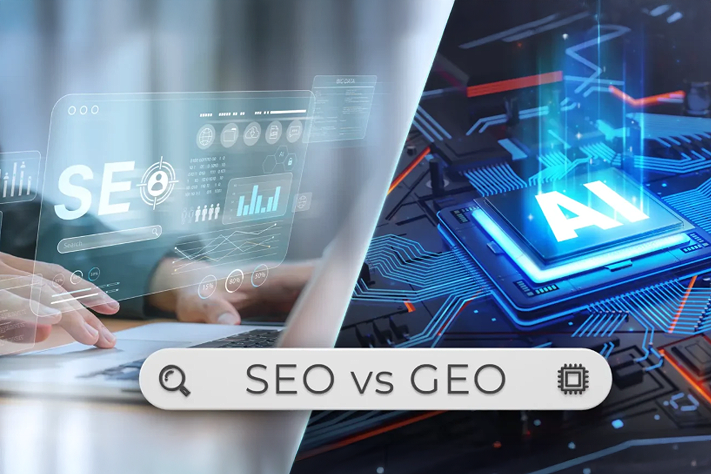Imagine waking up one day and realizing that search hasn’t changed; you have to evolve. Traditional SEO (Search Engine Optimization) used to be king: pick keywords, stack backlinks, tweak metadata, and climb Google ranking. That still matters. But now an entirely new player is emerging, GEO, or Generative Engine Optimization, which is about how AI-driven systems (like ChatGPT, Bard, or Bing’s generative layers) choose, assemble, and present answers.
In short, SEO focuses on getting your page listed high in search engines. GEO tries to get your content mentioned, cited, or surfaced inside AI-generated responses themselves. As AI becomes more common in everyday search, you need both strategies working together to stay visible. Bogo Solutions, being the trusted partner, is always a step ahead of all these updates and makes sure that you don’t suffer with the consequences.
What Is Generative Engine Optimization (GEO)?
Generative Engine Optimization is the practice of shaping content so generative AI systems see it, trust it, and include it in their responses. These AI systems don’t just list links; they synthesize, summarize, and sometimes quote content from multiple sources. GEO is how creators get their content into those answers.
GEO involves structuring your content with clarity, context, citations, and authority. It means anticipating how large language models (LLMs) parse the web and what signals they use to judge relevance and trust. In practice, that might mean stronger internal linking, better use of data, explicit references, semantic structure, and writing with the idea of “would this be helpful if pulled directly as an answer?”
GEO is still new. It’s evolving rapidly as different AI-driven systems adopt slightly different criteria for picking sources. But one thing is clear: if you don’t think about GEO, you risk losing visibility as more people ask AI models instead of typing into Google. With Bogo Solutions, businesses can structure content to maximize AI visibility while maintaining traditional SEO performance.
SEO vs GEO: How They Differ (And Why You Need Both)
Let’s put them side by side so you can see the differences clearly:
Feature / Focus | SEO (Search Engine Optimization) | GEO (Generative Engine Optimization) |
Target “engine” | Traditional search (Google, Bing, etc.) | AI-driven generative systems (ChatGPT, SGE, Bing Chat, etc.) |
Goal | Rank in search results pages | Be cited, quoted, or surfaced in AI-generated answers |
Signals | Keywords, backlinks, site speed, metadata, domain authority, user engagement | Content clarity, structured citations, semantic linking, trust signals, domain authority in AI view |
Metrics | Click-through rate, impressions, bounce rate, dwell time, rankings | AI citations, share of voice in AI answers, inclusion in generative responses, visibility in new AI layers |
Strategy | Broad content, keyword targeting, link building, and technical optimization | Clear structure, rich context, sources, “answer-ready” content, prompt engineering |
Result format | You get people clicking through to your page | Your content may appear directly inside the AI’s answer, sometimes bypassing click-through |
In practice, good SEO still supports GEO. A page with strong SEO is more likely to be considered as a source by AI systems. But GEO forces you to think deeper: how to make content AI-readable, answerable, and worth citing.
As SEO changes in response to AI, many of the old tactics (pure keyword stuffing, superficial backlinks) won’t move the needle. GEO is pushing the shift to content that can be directly used in AI answers.
How SEO Is Changing Under AI’s Influence?
AI is nudging SEO into a new phase. Some of the trends that illustrate how SEO is evolving:
From keywords to context: Content must not just repeat a phrase but answer deeper user intent in context.
More structured content: Use headings, lists, citations, and clear formatting so LLMs can parse and choose your content.
Authoritative sourcing: AI models favor content with credible references, original research, and domain reputation.
Less noise, more substance: Thin pages, fluff, or low-effort content risk being ignored by AI systems in favor of richer sources.
Prompt engineering influences: The way people phrase queries to AI matters. You might optimize your content for how people “ask” AI, not how they type in Google.
Overlap of SEO + GEO: You’ll need a hybrid strategy that serves both traditional searchers and AI-driven audiences.
These shifts don’t kill SEO. They force us to expand it. The classic SEO foundations usability, quality content, good structure remain vital. GEO just adds another layer of optimization.
The Role of Language Models in Search
Large language models have become the new interface for many users. Instead of typing into Google, they ask ChatGPT or their favorite assistant a question. The AI generates an answer by pulling from web sources, summarizing, quoting, and combining presenting what feels like a direct conversation.
Because of this shift, AI models effectively act as search engines. They decide which sources to trust and how to present the answer. Your content needs to be in the set of “trusted sources.” That changes what “ranking” looks like sometimes a ranking is just “are you cited or not.”
AI models also lean on retrieval-augmented generation (RAG) and citation-based methods, meaning your content may be used more if structured for extraction.
Generative Search Ranking Factors: What AI Chooses
So what makes one page more likely to be cited in AI-generated answers? Some observed signals:
- Clear, authoritative writing with correct facts
- Use of citations, links, references
- Well-organized structure (headings, headers, sections)
- Depth of coverage: enough context that the model can use it
- Domain reputation (trusted website)
- Relevance to the query context
- Unique insights or data that aren’t generic
- Consistency over time – keep content fresh
These differ from traditional SEO signals but build on them. In effect, GEO is forcing brands to produce content that is answerable by AI, not just discoverable.
Optimizing Content for AI & GEO: Strategy Tips
Semantic Structuring & Formatting
Write with AI in mind. Use clear headings, short paragraphs, numbered lists, sub headers that reflect common questions. The model should easily identify your content’s organization.
Prompt Awareness
Know how people ask AI questions. Write content that mirrors prompt structure. That increases the match chance.
Citation & Reference Strategy
AI often needs trusted sources. Use external links, authoritative quotes, factual backing. That boosts credibility in a generative answer.
Content Features Favored by Generative Models
Infographics, data tables, concise summaries, “In summary” or “Key takeaways” sections help AI pick parts of your content cleanly.
Content Extraction Friendly
Avoid overly nested or vague content. Make sure the AI can extract a complete answer snippet without needing to reconstruct context.
Combine SEO with GEO
Don’t abandon SEO. Use keywords, meta tags, and good link profiles. GEO builds on top of SEO for the AI era.
Measuring Success in GEO vs SEO
Traditional SEO success is measured by clicks, traffic, ranking, and bounce rate. In the age of AI, additional metrics matter:
- How often is your content cited in AI answers
- Share of voice in AI-generated responses
- Impressions inside AI interfaces
- Brand presence in answer summaries
You want both audience reach (SEO) and direct AI visibility (GEO).
Is GEO Going to Replace SEO?
It’s unlikely that GEO will replace SEO entirely. AI search is still maturing, and many users still use traditional search engines. But GEO will become a required component. As more people rely on LLMs, the importance of being visible inside answers increases. The future is hybrid.
In fact, marketing professionals now often describe the strategy as “a bridge between SEO and GEO.” Use classic SEO techniques to build a foundation, and GEO techniques to capture AI-era visibility.
Challenges of GEO & Why It’s Not Just Copy-Paste
GEO has its complications:
- AI systems are black boxes you don’t always know how decisions are made
- Different AI platforms use different criteria
- Your content may be cited in AI without driving traffic
- You need consistent authority and credibility
- Aligning your content structure and prompt fit is a continuous effort
- Measuring impact is harder (new metrics, new dashboards)
Case Studies & Brand Adaptation
Some brands have started to experiment. For example, companies that produce white papers or deep data-driven content see more AI citations. Where once blogs competed only for SERP positions, now they compete to be sources inside AI responses.
Smaller brands can adapt by producing high-quality niche content, using expert voices, structuring clearly, and seeking mentions in external publications so AI sees more signal.
The Future of Content Discovery
Search is shifting from clicking links to receiving direct answers. In that world:
- People trust AI interfaces
- Discovery happens conversationally
- Long tail queries become more important
- Brands must think like sources, not just pages
GEO is the strategy for that future.




